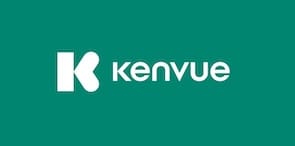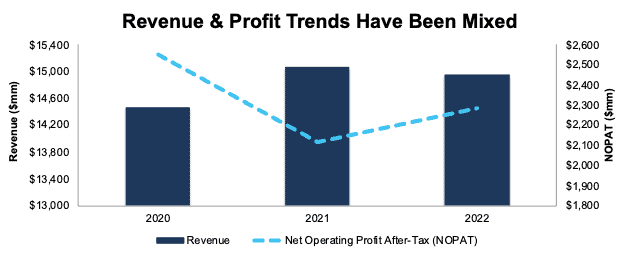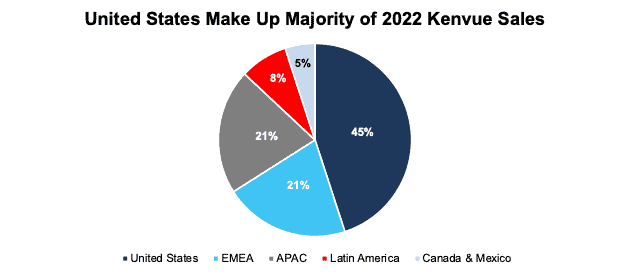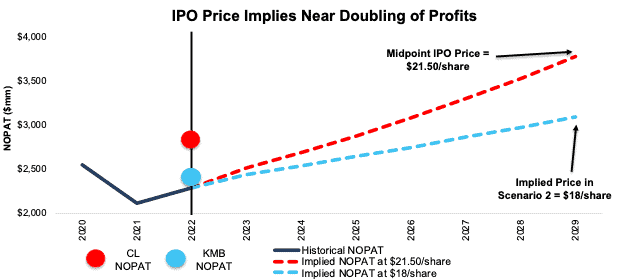Kenvue (KVUE: $20 to 23/share), the consumer health spin-off from Johnson & Johnson (JNJ), is expected to start trading May 4, 2023 at a ~$40 billion valuation. At $21.50, the midpoint of its IPO price range, Kenvue earns our Neutral rating. Note that most IPOs earn our Unattractive or Very Unattractive rating.
Kenvue has been profitable in each of the three years for which we have financial data. With some of the most well-known consumer brands in its stable, it will likely be profitable for many years to come. However, the company lacks the margins of its competitors, and a profitable company is not always a good stock. At its expected valuation, KVUE looks fully valued and does not provide investors with much upside potential, as we’ll illustrate with our reverse discounted cash flow (DCF) model below.
Investing in any IPO is not without risks, and our IPO research aims to provide investors with more reliable fundamental research.
Revenue and Profits Are High, If Not Always Rising
As a provider of some of the largest consumer health products in the world, Kenvue generated nearly $15 billion in revenue in 2022 and $2.3 billion in net operating profit after tax (NOPAT). In 2022, NOPAT was up 8% year-over-year (YoY) while revenue was down 1%, per Figure 1.
Figure 1: Kenvue’s Revenue & NOPAT: 2020 – 2022
Sources: New Constructs, LLC and company filings
Industry Has Many Tailwinds to Drive Steady Growth
In its S-1, Kenvue notes that the consumer health market grew at a compound annual growth rate (CAGR) of 4.8% from 2019 to 2022, and management believes the market will continue to grow at a CAGR of 3 to 4% globally through 2025.
Other industry analysts estimate the overall market could grow even faster – at a 7% CAGR through 2028. Either way, the growth in the overall industry is supported by long-term tailwinds, including but not limited to:
- More health-conscious consumers.
- More preventative-care focused healthcare providers.
- More retailers recognizing the growth in consumer healthcare and emphasizing such products in stores.
- Aging population across the globe.
- A growing middle class in emerging markets, which will provide more financial flexibility to buy more consumer health products.
Product Line Is Impressive
Kenvue refers to itself in its S-1 as “the world’s largest pure-play consumer health company by revenue”, and it’s hard to contest that claim. Many of Kenvue’s top 10 brands in 2022 (listed below) also hold the number one ranking in each respective market:
- Tylenol – #1 pain brand globally
- Nicorette – #1 smoking cessation brand globally
- Zyrtec – #1 allergy brand globally
- Motrin
- Neutrogena – #1 facial care brand in the U.S.
- Aveeno
- OGX – #1 premium hair care brand in the U.S.
- Listerine – #1 mouthwash brand globally
- Johnson’s – #1 baby toiletries brand globally
- Band-Aid – #1 adhesive bandage brand globally
And Kenvue Is Geographically Diversified
In 2022, Kenvue generated 55% of its revenue in regions outside of the United States. While the United States is still the largest market by revenue, Europe, Middle East, and Africa (EMEA) and Asia Pacific (APAC) each represent 21% of revenue in 2022, per Figure 2. Such geographic diversity positions the company to grow strongly as consumers in emerging markets attain greater spending power.
Figure 2: Kenvue Sales by Region: 2022
Sources: New Constructs, LLC and company filings
Competition Is Plentiful, and Kenvue is Less Profitable
There is no shortage of competition in the consumer health market, from industry stalwarts to startups and private labels in between. Given the breadth of Kenvue’s product offerings, it faces competition from a multitude of firms. Kenvue categorizes it competitors in five different groups:
- Consumer healthcare businesses, either independent or part of larger pharmaceutical groups
- Global consumer packaged goods companies
- Regional companies that operating in similar end markets
- Generic over-the-counter and private label brands
- Emerging niche-oriented brands with distribution through traditional retail or online direct to consumer.
More specifically, Kenvue’s competitors include the likes of Bayer Consumer health, Procter & Gamble (PG), Sanofi Consumer Healthcare (SNY), L’Oréal, Unilever (UL), Colgate-Palmolive (CL), Kimberly Clark (KMB), and more.
Unfortunately for investors, the company has not turned its high brand recognition into greater profitability. In fact, Kenvue’s return on invested capital (ROIC) ranks nearly last among its competition. Only The Clorox Company (CL) has a lower ROIC of the companies in Figure 3.
This low ROIC is driven by Kenvue’s 0.5 invested capital turns ratio, a measure of balance sheet efficiency, and is tied for last amongst competitors in Figure 3.
Figure 3: Kenvue’s Profitability Vs. Competition: 2022
Sources: New Constructs, LLC and company filings
Valuation Implies Optimistic Profit Growth Rates
When we use our reverse discounted cash flow (DCF) model to analyze the future cash flow expectations baked into KVUE, we find that shares, even at the midpoint, require optimistic assumptions about margins and growth, and look fully valued.
To justify the midpoint of its IPO valuation, our model shows Kenvue would have to:
- immediately improve NOPAT margin to 15.7% (3-year average, compared to 15.3% in 2022) through 2029 and
- grow revenue by 7% compounded annually (equal to the high end of industry projections through 2028) through 2029.
In this scenario, Kenvue would earn $24.0 billion in revenue in 2029, or 1.6x its 2022 revenue, and $3.8 billion in NOPAT, or 1.3x its 2022 NOPAT. This scenario implies Kenvue grows NOPAT by 7% compounded annually through 2029. For reference, Kenvue’s NOPAT has actually fallen 5% compounded annually since 2020. This scenario also implies Kenvue grows revenue at the industry growth rate, i.e. 7%, which is much higher than the 2% compound annual revenue growth rate Kenvue has achieved since 2020.
16% Downside if Growth Matches Management Industry Projections
We present an additional DCF scenario to highlight the downside potential in the stock should Kenvue grow sales at management’s expectation, which is lower than third-party estimates.
If we assume Kenvue’s:
- NOPAT margin immediately improves to 15.7% through 2029 and
- revenue grows 4% compounded annually (high end of management’s market estimate through 2025) through 2029, then
KVUE would be worth just $18/share today – a 16% downside to the midpoint IPO price range. In this scenario, Kenvue’s revenue would still grow to $19.7 billion in 2029, or 4% compounded annually. This scenario also implies the company would earn $3.1 billion in NOPAT and grow NOPAT 4% compounded annually through 2029. For reference, Kenvue’s NOPAT has fallen 5% compounded annually since 2020. In other words, even if Kenvue improves margins and grows revenue at the high end of management’s estimate, the stock is worth only $18/share. For reference, Kenvue’s economic book value, or no growth value, is $14/share.
Figure 4 compares Kenvue’s implied future NOPAT in these scenarios to its historical NOPAT. For reference, we also include the TTM NOPATs for competitors Colgate-Palmolive and Kimberly Clark.
Figure 4: Midpoint IPO Price Looks Fully Valued
Sources: New Constructs, LLC and company filings
Red Flags for Investors
Despite a less aggressive valuation relative to the IPOs of 2021 (with share prices that implied >100% of market share), investors should be aware that Kenvue’s S-1 also has some other red flags.
Public Shareholders Have No Rights
Johnson & Johnson, after spinning off Kenvue, will continue to own 92% of the voting power in the newly formed company. This structure means that Johnson & Johnson, not new shareholders, will be able to control the outcome of matters submitted to shareholders for approval.
In other words, this IPO will take investors’ money while giving them almost no voting power or control of corporate governance.
Talc-Related Legal Proceedings Are Still a Risk
As noted in the company’s S-1, a significant number of personal injury claims alleging that talc causes cancer have been made against Johnson & Johnson prior to the formation of Kenvue. As part of the separation agreement, Johnson & Johnson has agreed to indemnify Kenvue for “Talc-Related Liabilities” and any costs associated with resolving such claims. On April 4, 2023, Johnson & Johnson agreed to pay $8.9 billion over 25 years to claimants in a proposed settlement that will require bankruptcy court approval.
However, the S-1 also warns that Kenvue “cannot assure that the indemnity from Johnson & Johnson will be sufficient to protect us against the full amount of these liabilities or that Johnson & Johnson will be able to fully satisfy its indemnification obligations”.
The company also warns investors that it may continue to be subject to claims that fall outside of the previously indemnified Talc-Related Liabilities given that Kenvue still sells talc products in countries around the globe. The sale of these products will be discontinued in 2023, but the company still warns that litigation that isn’t covered by the indemnity remains a possibility and could adversely impact the newly-formed business.
This article was originally published on May 3, 2023.
Disclosure: David Trainer, Kyle Guske II, and Italo Mendonça receive no compensation to write about any specific stock, style, or theme.
Questions on this report or others? Join our Society of Intelligent Investors and connect with us directly.




